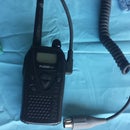Introduction: Add a Light to Your Motorcycle..not Just Any Light..
Adding lights to your bike almost seems like an art as it is what you ride or how often. I have been working on this for about 6 months until I came up with this idea. I have wanted to add a light where there is a reflector behind the front wheel on both sides. Until recently there was only one light on each side of my bike on the side cases.
As with any light you have to add wiring. I knew what I wanted to do, but couldn't figure out the circuit. This instructable allows you to add an LED with one wire that serves as a running light and a turn signal.
Additionally, only plugging the positve wire for my new light, into 1 positive source would only work when that circuit was on (my turn signal, as probably many others, turns off the running light for the blink circuit to work, it isn't the same wire.
So I wanted 1 light to do both functions, a running light and blink, with 1 wire. Here's how I did it.
Pictured above are all of the components necessary, the LED, with mounting bolt glued with epoxy, 2 diodes N4001 and the the wire, approximately 16 gauge, much thicker isn't necessary for the low draw of 30ma or much thinner so it doesn't break while working with it.
In the second picture I twisted the diodes together then wrapped one end of the wire and soldered. It is important to orient the diodes properly so electricity can pass from your "positive source" to the positive lead on the LED.
Why are their two diodes you ask? I am pushing each end of the diode into each positive source in my turn signal, there are 3 wires, ground, turn signal positive and running light positive. With the minus sign on the diode facing a way from the positive source, no matter which signal is coming through the wire you added, it will not travel up the other wire. The minus sign does not allow electricty to pass in this direction, the ground.
In the third, fourth and fifth picture, shows a technique that I like very much, it keeps wiring looking very nice.
You place the wires together as I have here, about in the middle to each other. As you twist them together, the ends of them should finish before they reach the insulation on each end. When you heat shrink around them, after you solder, the finished product will look like a smooth, single wire. The alternative if you twist them together, like a wire tie, you will have to lay it over and it will be more bulky.
In the last picture, it shows where I found the two sources of positive wires, depending on whether the running light or turn signal is selected. It looks like I will just be able to find a way to push the wire of the diode in to make it's connection. There are much more elaborate ways to finalize this, add an LED and tell me what you did.
I am going to submit this now, because other than wiring it on the bike and taking final pictures, the light and the circuit are ready to be made by you.
Lastly, working with diodes is pretty awesome. They are .02 each and they are mostly responsible for converting AC into DC or reducing voltage by .7 volts per diode, and you only need four of them.
In this circuit, with only one diode per positive source it reduces the voltage from 13.75 volts, while the engine is running to 13 volts. Still makes a nice, inexpensive way to add light to your bike.
The LED is waterproof and available at Harbor Freight, for around 6.50 to 8 dollars.














